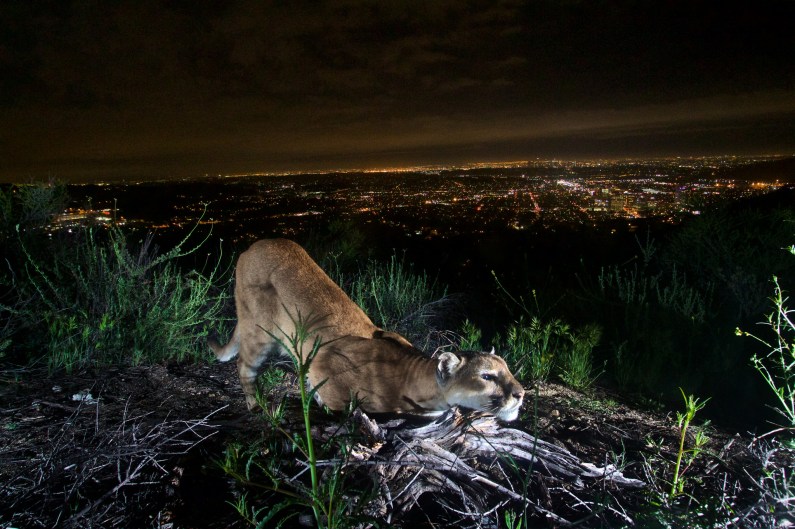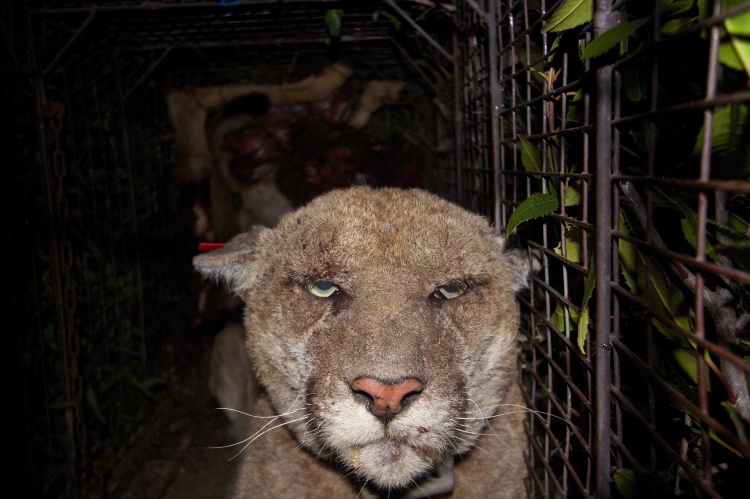
Introduction
On May 15, I tuned into a webinar hosted by WildFutures: a project of Earth Island Institute which uses science and the media to challenge negative perceptions of large carnivores. The title of the webinar was Big Cats in the City: Ecology, Behavior, and Conservation of Mountain Lions around Los Angeles.
With nearly 180 people in attendance, Big Cats in the City was a popular webinar. Dr. Seth Riley, a wildlife ecologist for the National Park Service (NPS), was the presenter.
For the past 18 years, Dr. Riley has worked at the Santa Monica Mountains National Recreation Area on the outskirts of LA. He has been investigating the effects of roadways and urbanization on mountain lions (Puma concolor), and on May 15 he shared a little of what he had learned.
Below is an overview of some of the key points Dr. Riley discussed in Big Cats in the City.

Synopsis
History
- Los Angeles is one of only two megacities to host a population of big cats: the other being Mumbai with leopards.
- The National Park Service began studying carnivores in the Santa Monica Mountains in 1996 because they need considerable space to survive. Large carnivores are, in certain regards, the “ultimate conservation challenge.”
- The NPS has specifically studied mountain lions in the Santa Monicas since 2002.
LA’s Lions Need More Room

- There is only room for 10-15 adult and subadult mountain lions in the Santa Monica Mountains Recreation Area.
- This is not enough to maintain the cats’ genetic viability.
- To compound the problem of limited space, much of the land within the Santa Monicas is privately owned. This is producing development pressures and habitat fragmentation inside the park.
- Highway 101 acts like a barrier on the northern edge of the Santa Monicas: preventing mountain lions from moving into and out of the park.
- This is leading to high levels of inbreeding, which will eventually compromise the ability of LA’s mountain lions to survive. There have been four documented father-daughter matings.
- The inability of subadult males to disperse out of the Santa Monicas is also provoking more intraspecies (within species) fighting. Out of 20 males born since 2002, 43% have been killed in such conflicts.
- If LA’s mountain lions are to survive, they need to be able to cross the 101.
- For this reason, the National Park Service and concerned citizens want to build a wildlife overpass over the 101.
- Dr. Riley and his colleagues have already identified the ideal spot for the overpass: Liberty Canyon. It features natural habitat on both sides of the highway.
- Having 10 lanes of traffic, this would be the largest stretch of highway with a wildlife overpass.
- The key hurdle to overcome for this overpass is money.
- According to the Save LA Cougars campaign, this project would cost 60 million US dollars.
- You and I can contribute by donating to the Santa Monica Mountains Fund or the National Wildlife Federation.
Anticoagulant Rodenticides

- As in northern California, anticoagulant rodenticides are a major problem for mountain lions near LA.
- Due to their position at the top of the food chain, mountain lions accumulate large amounts of these toxins.
- 90% of tested mountain lions contained anticoagulant rodenticides in their bodies.
- These toxins kill mountain lions and other wildlife by causing them to bleed to death internally.
- Mountain lions P3 and P4 both died from anticoagulants.
Video
The above section is a highly condensed version of what I considered to be the most important pieces of information from the webinar. Below is a recording of the entire presentation.
Conclusion
In Dr. Riley’s own words, it is “amazing” that we have mountain lions in Los Angeles. But if the cats are to persist, they need more room and reduced exposure to rodenticides. Donations to the Santa Monica Mountains Fund or the National Wildlife Federation can help with the crucial goal of building the Liberty Canyon overpass.
Great reading.
Thanks
LikeLiked by 1 person
Thank you!
LikeLike
What a beautiful all these BIG CATS dear John, and I am looking after Little Big cats :) Thank you, Love, nia
LikeLiked by 1 person
Haha, little big cats can be a lot of work!
LikeLiked by 1 person
I didn’t know there were mountain lions in Los Angeles! Though I’ve seen a documentary about the leopards in Mumbai. They feed on wild boars there, I believe.
LikeLiked by 1 person
Well, the situation in Los Angeles is a bit different than Mumbai. In the latter city, the leopards live in a small national park in the heart of the city – and many of them were brought there by government workers. The mountain lions in Los Angeles live just on the outskirts of the city, and have been there since long before the city was.
Yes, I’ve heard that the leopard in Mumbai largely feed on wild boars; I’ve seen footage of a mother leopard killing a piglet. They also traverse to city streets at night sometimes, preying on stray dogs. Apparently Mumbai has an abundance of stray dogs, and the leopards are actually providing a valuable service by reducing their population. It’s not all good though: people have been attacked and killed by Mumbai’s leopards. I don’t think there have ever been any attacks in LA, but I could be wrong.
LikeLiked by 1 person
I’d hears about these mountian lions in school- a large number of big cats just outside of the city. Apparently they remain quite reclustive and are not often spotted relative to the human population. It is fascinating, also slightly sad. Two mountain lions were shot in Port Coquitlam this week- a city not far from Vancouver. Thank you for sharing.
LikeLiked by 1 person
Yea, the LA lions seem to be very good at not being seen by people. In the webinar there is a photo of a mountain lion literally walking down an urban street: surrounded by cars and buildings. But it was night time, so I’m guessing no one saw it. Apparently most of the LA cats avoid built up areas, but a few are more willing to traverse them than others.
LikeLike
Wow! Mountain lions are amazing creatures. I was surprised to hear that Los Angeles is one of two mega cities to have big cats! This was a very interesting post.
LikeLiked by 1 person
Yea, a mountain lion got trapped in someone’s house a few years ago and made a big news story! But when people have him some space he got out of there as fast as he could.
Mountain lions are incredible animals. But unless we can build the overpass over Highway 101 and reduce the cats’ exposure to poisons, Los Angeles may not have mountain lions in the not-too-distant future.
LikeLiked by 1 person
Wow! I find it funny though how we, as humans, get annoyed when animals enter “our land” when we basically stole their habitats and destroyed them. I hope that overpass gets built despite the cost, it’s important to protect these animals!
LikeLiked by 1 person
Yea, it is funny how we freak out when animals enter “our” spaces. Funny, arrogant, and absurd.
I think the overpass will get built; it’s just a matter of time.
LikeLiked by 1 person
Yeah, humans are selfish creatures 😂 That’s good!
LikeLiked by 1 person
Brilliant post Josh – well done :)
LikeLiked by 1 person
Thanks Rory!
LikeLiked by 1 person
We don’t get big cats in Australia, so this was really interesting, thanks for sharing!
LikeLiked by 1 person
Thank you! There might not be any big cats in Australia, but you have an abundance of fascinating creatures that are found in very few other places – if any. You’re incredibly fortunate to live in such a unique continent.
LikeLike
You’re welcome my friend.
By the way l have tagged you into my 321 Quote Me game today – the topic is conservation :)
https://aguycalledbloke.blog/2018/06/06/3-2-1-quote-me-14/
LikeLiked by 1 person
Thanks Rory!
LikeLiked by 1 person
What are the chances of building a bridge, do you think?
LikeLiked by 1 person
Pretty good, if we can raise enough money. People in southern California seem to be largely supportive of the overpass.
LikeLiked by 1 person
Good luck!! 👍
I think the rodenticide is going to be the bigger problem.😩
LikeLiked by 1 person
It might be a bigger problem in the short term, but even if we remove all the rodenticides from the environment, genetic isolation will eventually lead to the loss of LA’s lions.
LikeLiked by 1 person
So sad – and so great you are working on it!
LikeLiked by 1 person
Thanks Josh for sharing our webinar. I love your website, by the way. Our next and last webinar in the 2018 Wildlfe Webinar Series, “Living with Mountain Lions in the Bay Area” is September 20th. We have other excellent wildlife webinars on our website. You call find them at wildfutures.us, and navigate to webinar archives. For all things wild and free, Sharon Negri, Director, WildFutures
LikeLiked by 1 person
Thank YOU for commenting, Sharon, and for putting together such interesting webinars. I already have your September 20th webinar on my calendar. I’m looking forward to it!
LikeLike